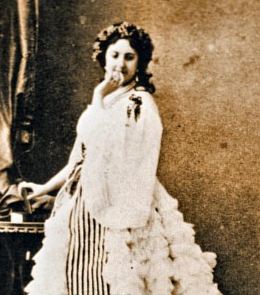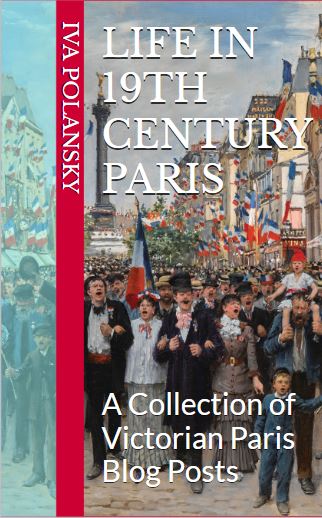
A previous post, The Spectacle of Paris Streets, described random free spectacles. The largest and most ostentatious free show had a steady schedule. Every day, between 2:00 and 4:00 PM, the wealthy shamelessly expotsed their luxury to each other, and to the unwashed masses, in the Bois de Boulogne parade.

Before becoming the favorite place of the Parisian society in the 19th century, the Bois de Boulogne had a history. Originally, the forest extended on the plains and hillsides of the right bank of the Seine. A landmark of brigands and vagabonds, the ancient forest was also the favorite place of royal hunts. At the end of Napoleon I’s regime, it was devastated by the occupying troops who encamped there. Although in poor condition and crossed by narrow roads of dismal quality, it became nevertheless, around 1830, the rendezvous of all Paris society.
In 1852, the State yielded the wood to the city of Paris with the charge of its development and maintenance. Emperor Napoleon III had envisioned the creation of a large landscaped park similar to Hyde Park. The project was entrusted to the engineer J.J. Alphand who created two lakes, the largest of which measures 19 hectares. Various amenities – large alleys, the racecourse of Longchamp (opened in 1858), the Garden of Acclimatization, and several restaurants – completed the whole landscape.

During the Second Empire (1852-1870), the equestrian rendezvous at the Bois de Boulogne was rated as a meeting of the supreme social chic. The chroniclers of the time tell us of its splendor:
“At the height of luxury was the attelage à la Grand Daumont, with its postilions in livery— of sober or bright colors according to the tastes of the masters—the footmen behind the hood, arms crossed, the two men in a row on horses of the same dress as the four draft horses. Then there came the eighth-spring, the queen of the passenger carriages. There was also the elegant half-Daumont of a duke with horses very close and absolutely under the whip of the gentleman-coachman who drove almost standing. The tandem cabriolet was another fantasy designed to bring out the talent of the gentleman-coachman. Then came a cute cart dragged by two pretty ponies under the hand of the elegant lady who also wanted to show that she could hold the reins. All aristocratic, luxurious and worldly Paris was there, struggling with elegance and sumptuousness … “

Romance, or the carnal desire, also played its part. The poet Beaudelaire best describes the mood:
“Sometimes a horseman gallops gracefully beside an open carriage, and his horse appears, by his bows, to salute in his own way. The carriage carries away, in an alley streaked with light and shade, the beauties lying as in a boat, indolent, vaguely listening to the gallantries fall into their ears and indulging themselves lazily in the wind of the promenade. The fur and muslin rise to their chins and overflow like a wave over the door. The servants are stiff, perpendicular, inert, and all alike; it is always the monotonous and featureless effigy of punctual, disciplined servility … “

On the part of the great courtesans, luxury was no less brilliant. The famous Madame Musard had a half-Daumont, whose postilions were dressed in violet livery and mounted black horses of admirable beauty. Cora Pearl had set up her stable and led it with such authority that gossip spread on how she must have been raised by a groom. Adele Courtois, Caroline Letessier, and La Barucci, famous for the Baccarat Scandal, involving the Prince of Wales, all had their car driven in the Daumont style, and their livery could compete with those of the oldest houses of the Faubourg Saint-Germain.

Lady Harriet, the courtesan who financed the emperor while he was waiting for his crown, used colors similar to the imperial livery. Madame Lejeune had the audacity to do better. She took the imperial colors outright. One day, her Daumont went out, preceded by scouts in green and gold, with a hunter on horseback at the left door and two carriage boys following also on horseback. As she had a certain resemblance to the Empress, all the sergeants of the town who saw the arrivael of this crew on the Place de la Concorde, rushed forward, made room for them, and finally raised the chains of the Arc de Triomphe, so that the sovereign could pass. She went in this style to the entrance of the Bois. This adventure made a big noise in the newspapers as well as at the Court. As a consequence, it was expressly forbidden to employ a livery which, even approximately, recalled that of the Emperor.
This luxury only grew from year to year. It was at its peak in 1867 at the time of the World Exposition. With the fall of the Empire, the splendor would gradually fade: the walks in the Bois and participation in the various events took a different, more bourgeois, look.

During the siege of Paris, part of the food supply of fish and game came from the Bois. More destructive authorization was given to the trade of timber dealers to exploit the Bois de Boulogne. The devastation increased during the battles between Versailles and the Communards. After the war, the southern part, the most devastated, was transformed into the racecourse of Auteuil. From 1872, social life resumed and one could see again the parades of carriages crossing the Bois for the Grand Prix de Longchamp.

After the Great War ended in 1918, this activity declined. The prodigal nobility of the nineteenth and early twentieth century no longer existed. Only the profiteers of war, the new rich, held the high ground and the automobile took over. An époque had ended.
.
Related posts:
The English Courtesan that Made a French Emperor
The Guide to Gay Paree 1868: Sightseeing
.
If you enjoy reading these posts, support the author by purchasing her books on Amazon:
.

.



























